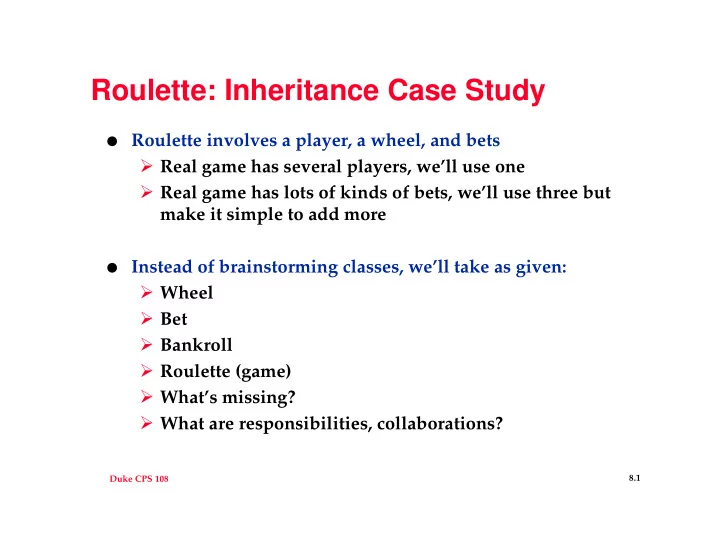

Roulette: Inheritance Case Study ● Roulette involves a player, a wheel, and bets � Real game has several players, we’ll use one � Real game has lots of kinds of bets, we’ll use three but make it simple to add more ● Instead of brainstorming classes, we’ll take as given: � Wheel � Bet � Bankroll � Roulette (game) � What’s missing? � What are responsibilities, collaborations? 8.1 Duke CPS 108
What are scenarios? ● User/player given choice of bet � Bet choice made � Wager made � Wheel spins � Payoff given � Play again? ● What happens when player bets? � What’s recorded? � How is winning determined? � What about multiple players, multiple bets? 8.2 Duke CPS 108
What is a bet? ● Difference between wager and bet � Bet contains wager amount � Different bets have different payoffs ● What happens after the wheel rolls and payoff occurs? if (myBet == redblack) … else if (myBet == oddeven) … � Problems with this? � Open closed principle? � Canonical OO tenet: avoid chains of if/else (when you can) 8.3 Duke CPS 108
Roulette Class Diagram Has-a relationship ● � Bet has a wheel, how/why? � BetFactory has bets � What bets? � Game has a bankroll � Does this make sense? Uses-a relationship ● � Parameters � Return values � Local variables Has-a relationship ● � Inheritance, use-as-a � Substitutable for-a 8.4 Duke CPS 108
Inheritance guidelines in C++ ● Inherit from Abstract Base Classes (ABC) � one pure virtual function needed (=0) � must have virtual destructor implemented � can have pure virtual destructor implemented, but not normally needed ● Avoid protected data, but sometimes this isn’t possible � data is private, subclasses have it, can’t access it � keep protected data to a minimum ● Single inheritance, assume most functions are virtual � multiple inheritance ok when using ABC, problem with data in super classes � virtual: some overhead, but open/closed principle intact 8.5 Duke CPS 108
Designing hyperwag ● Keep classes small and cohesive � as simple as possible, but no simpler � member functions should also be small ● Design for change � specifications, requirements, design � example: other formats for table design? ● Design first, code second, but revisit design ● Know the language, but don’t let the language rule the design ● Get the classes right, concentrate on what not how 8.6 Duke CPS 108
One view of hyperwag 8.7 Duke CPS 108
Patterns: Abstract Factory ● Abstract Factory/Factory aka “kit” � system should be independent of how products created � system should be configured with one of multiple products (or families of products, e.g., Win95, Motif) � you want to provide a class library of products and reveal interfaces but not implementations ● Consequences � factory encapsulates responsibility and process of creating objects, clients only see abstract interface. “Real names” hidden in factory � supporting new products can be difficult depending on the situation (but see Prototype pattern) ● Often want only one factory accessible in a program 8.8 Duke CPS 108
Patterns: Singleton ● Singleton � enforce exactly one instance of a class, accessible in a well- defined manner � possible to extend via inheritance ● Consequences � controlled access to single instance, e.g., Foo * foo = Foo::getInstance(); � no global variables � no need to rely solely on class/static functions ● Implementation � private constructor � getInstance (or other class/static functions, see hyperwag) 8.9 Duke CPS 108
Patterns: Prototype ● Use a prototypical instance to clone new objects � classes used in a program can be specified/loaded at runtime � avoid hierarchy of factories that parallels hierarcy of classes ● Abstract Prototype class implements clone() � how to copy? deep vs. shallow � how to initialize clones in subclasses ● Managing Prototypes � use a factory or a prototype manager with registered prototypes � cloning can be tough (e.g., circular references) 8.10 Duke CPS 108
Recommend
More recommend